Contents
The right choice and also putting textured paint demand separate consideration. Still new material is not absolutely mastered by owners of cottages, dachas, apartments. What the impressive colourful structure what types are offered buyers what decorative effects can be gained is attractive by, using impressive coloring — we consider a novelty from the different parties.
Textured paint for walls
The people familiar with decorative plaster, meeting finishing finishing from FKM, subtleties of "manufacture" can be surprised, without noticing "dirty trick". And "dirty trick" is that for finishing the decorative structure differing from plaster not in material, and technology of drawing was used.
Therefore we will talk about how it is correct to choose textured paint for walls how to cause structure whether it is possible to make such mix with own hands.
What is it
New material for front or interior finishing finishing reminds mixes of decorative plaster.
Serve as components of the colourful material (CM):
- binding (basis);
- fillers (sand, stone flour, etc.);
- teksturoobrazovatel (fibers, shredded gas-silicate, stone crumb);
- thickener (the modified starch);
- decorative inclusions (flocks, etc.);
- color;
- the modifying additives.
All these components which are evenly mixed represent the dense viscous weight suitable for formation of the invoice plaster tools or by means of make-shifts. Impressive KM (FKM) combine properties of paint and, at the same time, filling, performing functions both.
It is theoretically possible to make finishing weight independently. It is also possible to bring in basic weight additional components before use.
The technical characteristics specified by the producer:
- density – 1.5 g / cubic cm;
- quantity of cycles of freezing (for front structures);
- temperature condition (front structures are exploited in conditions - 40 ° C – +40 ° C)
- mechanical durability;
- rn;
- elasticity – the size of lengthening of the stretched film;
- vapor permeability;
- moisture resistance;
- adhesion (FKM have ability it is tenacious to keep on the metal, glass, plastered and wooden surfaces and also "stick" to a fibreboard, gypsum cardboard);
- expense on a layer (it is various for different structures);
- solvent share (waters – since 5%);
- drying time ~ 2 hours;
- resistance to UFL (it is necessary for facades, first of all);
- color (usually sell not tinted mass of white color);
- environmental friendliness;
- service life (generally up to 10-20 years).
Structures as a basis:
- Mineral, forming a covering on the basis of cement knitting. Are moisture resistant, paropronitsayema, are not elastic, plokhoustoychiva to vibrations, temperature jumps. The last properties limit application only to interiors. For adaptation to street conditions modifiers are required.
- Vinyl, forming a film, steady against atmospheric actions. Application universal (in interiors – it is limited as it is almost impenetrable for breath of walls). There are difficulties in drawing.
- Silicate (on zhidkostekolny binding) use on facades. Form the layer having high durability resistant to the external influencing factors. The considerable expense, volatiles which are emitted when drying limit use. Not for all bases perhaps direct drawing. Apply primers with a silicate basis to such cases.
- Silicone. The paint and varnish decorative weight which does not have a smell on the basis of a silicone emulsion. It is elastic, strong, durable. Application is universal. Protects from moisture, allowing "to breathe" the basis.
- Acrylic – very popular FKM. Are plastic, strong, eco-friendly. Application is universal. Are diluted with water. Low-racks to UFL.
Structures in the place of application:
- front;
- interior (only for the heated rooms);
- universal.
Impressive versions:
- KM with a quartz crumb. Besides a crumb in structure there can be metal particles (more often aluminum). The crumb allows to create a relief pattern even the simple pallet.
- Marseilles wax. The basis, steady against moisture, with wax filler allows to create protection for the bases. Will be suitable for damp and dry rooms. The texture of a covering reminds is opaque the gleaming stone surface.
- Atakama with quartz sand gives a covering with velvet effect at the expense of the reflecting effect. Metal particles of structure are responsible for effect.
- Mizuri contains acrylic dust and the modified starch. Layers turn out equal or impressive (depends on technology of drawing). The surface differs in weak luster.
- Structures with "bark beetle" - effect. Put to similarly decorative rolling plaster or plaster "bark beetle".
-
Wet silk. A polymeric color and fibers (cotton + viscose) – structure fillers. Use for creation of effect of fabric.
- Flokovy mix contains flakes.
Advantages and shortcomings
As minuses are not enough, we will begin with them:
- because of thickness of a decorative relief layer big expense;
- cost is higher, than traditional LKM;
- speckled by a relief pattern, the wall accumulates dust more smooth surface;
- it is not always maintainable.
Such pluses:
- Material gives in to different ways of processing, creation of various effects is as a result reached. Richness of decorative properties.
- Finishing is carried out and dries quicker, than putting hard putty with coloring on the finish.
- More economically.
- The covering can be washed.
- Environmental friendliness.
- Good adhesion.
- Durability.
Types
Application conditions in the building are various, depend on purpose of rooms. Living rooms: the bedroom, a study, the living room belong to dry. For kitchen fluctuations of temperatures are peculiar, to humidity, big mechanical loadings.
The bathroom, laundry, bathroom – objects with quickly increased humidity. According to conditions select KM basis type (it is possible to choose the most suitable from types).
It is more preferable silicate materials with translucent equal thickness of light tones to ceilings. For walls – the structures with fibers forming a surface with the fabric effect creating feeling of comfort.
In rooms of the average size it is possible to use melkorelyefny patterns. Deeper invoices suit for the big areas and also for the small sites limited to frames. Small rooms "will visually grow" if to paint them with light structures with nacre
In corridors and also on those sites of walls which undergo big mechanical external loadings (blows, attrition) take structures of high durability. And, considering a possibility of the increased pollution, select easily washed KM. In bathrooms paints waterproof are relevant. Here acrylic mixes are appropriate.
Less expensive acrylic mixes do not suit for exterior finishes because of fast burning out. They are simple in drawing, have a rich palette, but are less resistant to sunshine. Well proved vinyl paints. Resistant, easily washed a rain, silicate structures and also silicone — the good choice for any bases.
How to apply textured paint
FKM do not demand especially careful smoothing of surfaces of the basis as the created relief hides small defects, and the structure is caused with a layer thicker, than usual paints and varnishes.
In practice, putting textured paint is carried out (depending on desirable finishing effect) by means of pallets, a trowel, a brush or the roller and even a sponge.
Preparation of walls allows to increase adhesion, to prevent a prostupaniye of spots, paint flaking, emergence of the centers of biogrowths. After priming and drying drawing a layer of FKM, formation of a pattern is made. The last stroke – drawing a protective coating.
It is possible to apply textured paint in the conditions of the street only in a calm weather when rainfall is not expected. It will protect structure from dust, washing out, will provide the natural course of processes of hardening. The optimum mode of temperature +5 – +30os. The painted site should be pritenit that direct rays of light of the sun did not get on fresh crude structure.
For coloring by textured paint of surfaces indoors it is necessary to take care of illumination of a working surface. It has to be similar to that which will be at operation.
The invoice creates a light-and-shade pattern therefore change of provision of a light source can strongly influence perception.
The painting impressive structure before drawing is prepared. Ready mixes mix to bring the settled heavy components to hover. When jelling add up to 1% of water.
Dry mixes are shut warm tap water, mixed, add a color and mixed repeatedly. It is possible to make trial vykras for check of the turned-out tone.
Capacities with KM after work do not leave open. They need to be closed hermetically that weight did not dry up, it was not dehydrated. After putting textured paint on a wall polymerization begins. Full hardening comes to the end after 2 weeks (on drying of several layers day is required).
Further we will in detail sort each of above the described stages of works.
Preparation of walls
The surface is cleaned from the formed dirt.
- If the former covering is fragile, it is deleted.
- Repair each large crack. The small cracks which are not menacing to walls can be closed by the painting structure.
- types of spots (vysola, rust, fungus, fat) clean. For this purpose it is possible to get the necessary means.
- Delete an excess fixing hardware.
- If the surface insufficiently equal, it is leveled.
- Stick or cover with a film not painted surfaces (frames of windows, door blocks, sockets).
- Delete dust.
- Ground on 1-2 passes.
Putting soil
Buying primer, it is necessary to remember that structures priming and painting were combined (important correctly to pick up priming means). Priming solve a problem of saving KM, binding of dust and increase in adhesion. As a part of primer there can be disinfecting additives.
Means is put with the roller or a brush. The priming film has to be without admissions, uniform thickness. After a break (which duration is specified by the producer) put the second layer. It is desirable to do it in the direction, cross to previous. Drying finishes preparation of the basis.
Ways of putting textured paint
Putting textured paint can be carried out by many ways, different tools. All this generates abundance of effects.
The easiest way:
- Drawing basic weight the pallet with a wide shovel of a thick layer (is not thinner 3, 15 mm are not thicker).
- The surface of the put layer is processed in addition, putting a pattern with various tools: brushes, brush, trowel and so forth. The choice of the tool depends on what effect y you wish to achieve.
- In the last turn the finishing covering is put: varnish, wax, etc. (finishing finishing is applied only at will).
Besides, drying up, solution "usedat", therefore, the fresh layer put with a row will be (at orientation of thickness on previous) thinner. In turn it also usyadt, having created noticeable to eyes the hollow (shadows will help to make it more distinct).
Put weight from one corner of a wall to opposite. The applied paint keeps plasticity an hour and a half. During this time it is necessary to cause the invoice.
Briefly we will describe the most widespread ways of processing of the put basis.
Brush
Putting textured paint a brush depends on length of her bristle and also the direction of dabs, receive different patterns. So, the brush with a short bristle gives mazkovy effect, put dabs in the necessary direction. Thin long lines turn out when maintaining a brush with long pile.
Roller
The effects created by the roller depend also on fur coat type. It is possible to use impressive rollers for receiving patterns as that is done, processing decorative plaster. It is possible to make the impressive roller independently
Trowel
Simple movements of a trowel receive several kinds of impressive patterns. For example, the working platform of the tool is "pasted" to the surface of solution and allocated perpendicularly for the basis. Weight tries to keep step with a trowel, forming combs-potyagushki.
It is possible these combs at an otjyatiya (to a separation) to wrap trowels in the necessary party, having created similar to petals bends. Patterns receive also the special equipment of dabs.
Other ways
Putting textured paint can be varied. For this purpose it is not obligatory to use hand tools. Put and form weight, for example, by hands or a kartushny gun with a diameter of nozzle of 3 and more than a mm. Air pressure for a gun – is not lower than 5 atmospheres.
Except creation of a one-color decor apply drawing several layers of FKM of different color. Will help to diversify a sponge pattern, make-shifts which form paint by the hands, for example, plastic lumps of packages, cliches, brushes, combs.
Finishing covering
Together with textured paints use also:
- usual paints (for toning or drawing a color pattern);
- the Marseilles wax (use over impressive structure);
- enamel for toning of deepenings;
- additional decorative substances.
For highlighting of speakers of parts of a pattern use the equipment of a dry-brush, local imposing of spots a sponge. Apply enamel to an otteneniye of deepenings, for example, an azure.
Impressive translucent play of light is created in the thickness, covering with wax a basic layer of structure with a quartz crumb, filling in deepenings and leveling top of the plane of a binary covering it is delicious. In varnish of metal dust, glitters or nacre the special effect gives decorative toppings and addition.
Versions of possible invoices
Invoices belong to popular:
- bark beetle (rolling of granules is done also as roll plaster grains);
- fur coat (put with the roller);
- craquelure (picturesque cracks at a covering of a fresh paint coat are formed by varnish).
How to make textured paint with own hands
With structure of a basis it is possible to experiment, thereby to receive new interesting means with the necessary decorative or operational properties.
Basis
Usually as a basis, doing textured paint by the hands, take acrylic or water emulsion KM (for an interior), silicone (for a facade). Paint easily accepts loose fillers, forms a strong film.
Usually filler share no more than 10%. It is necessary to use the recipe with care. Having gone too far in a share of filler it is possible to receive the finishing which is showered from touch.
What fillers are used
As filler of acrylic paint use:
- quartz sand;
- cotton or viscose fibers;
- stone crumb (for example, marble);
- flocks;
- nacre and other decorative components.
Color
Any color which is applied to acrylic paints is good (more preferably water-based, universal).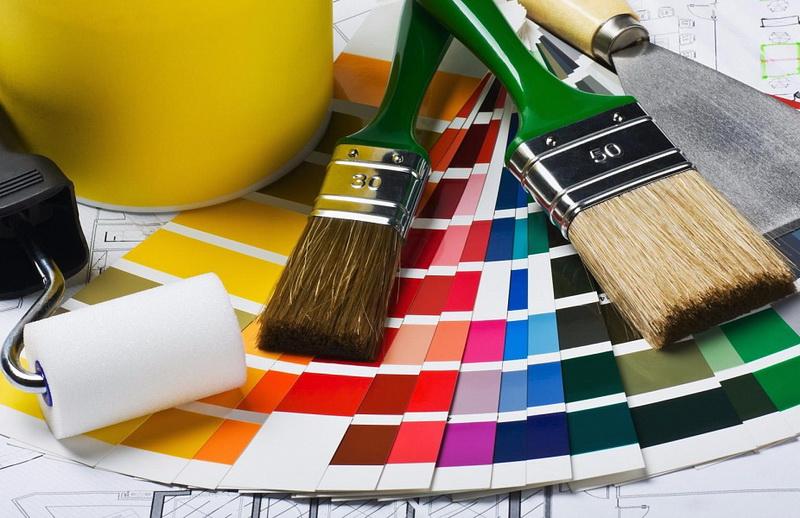
After addition of a color do trial vykras as the dried covering can turn pale that will demand dye additive.
Care of the painted surface
After polymerization passing the covering can be washed. Dust is deleted with soft brushes or the vacuum cleaner.
Popular producers of paint
The impressive KM adapted for conditions of Russia are produced by VGT.
Lakra (also Russian company) delivers quality materials (the atmosphere, strong, resistant to influences).
Paints from Blancolor with effect of waxed plaster and imitation of silk are interesting.
Paints from Amourcolor are most popular. They are famous for the increased wear resistance rich with a palette and structures by means of which various effects are gained. For example, Perlata gives to a surface a nacreous shade of pearls. Allows to imitate a marble mosaic Tactite.
Application options in design of a photo
In gallery it is possible to see a set of the ideas of use of textured decorative material.



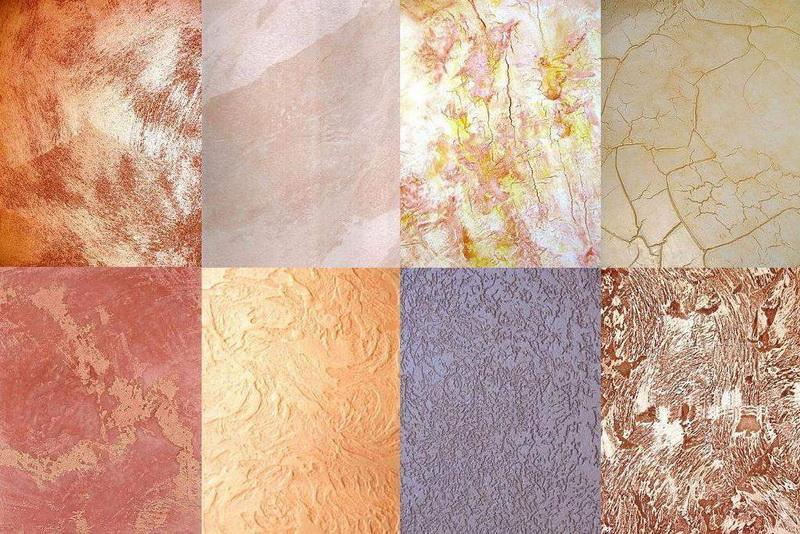







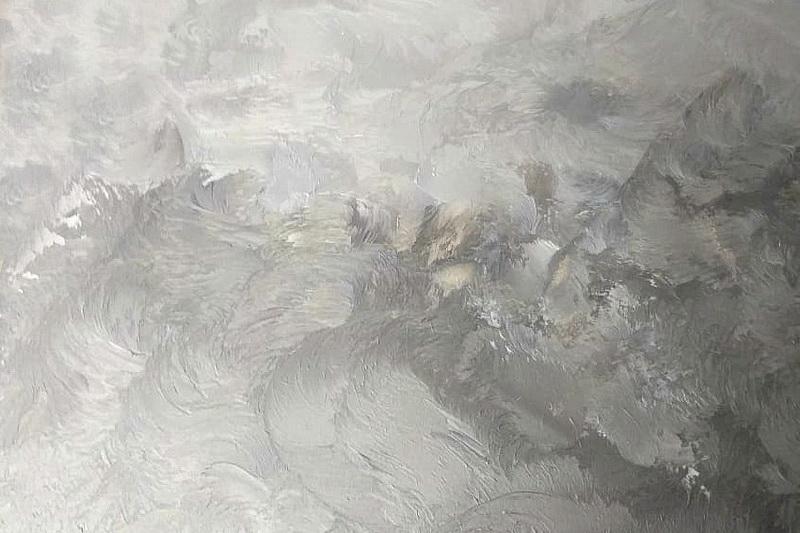


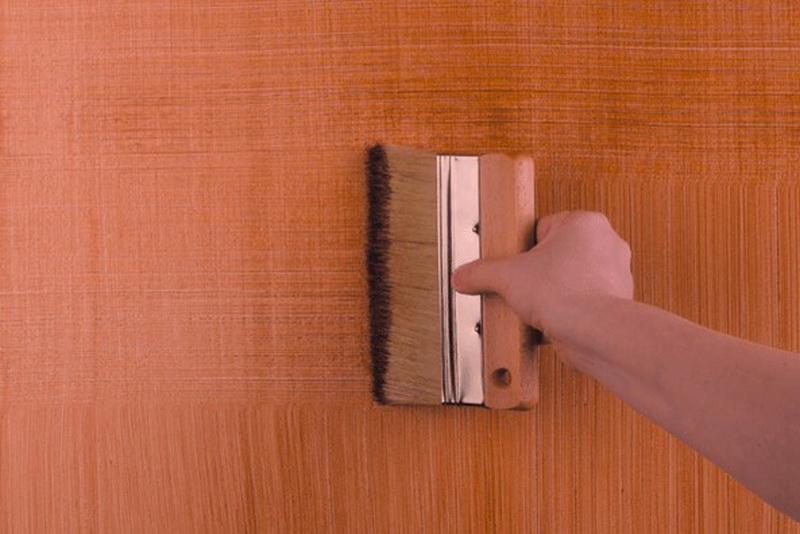
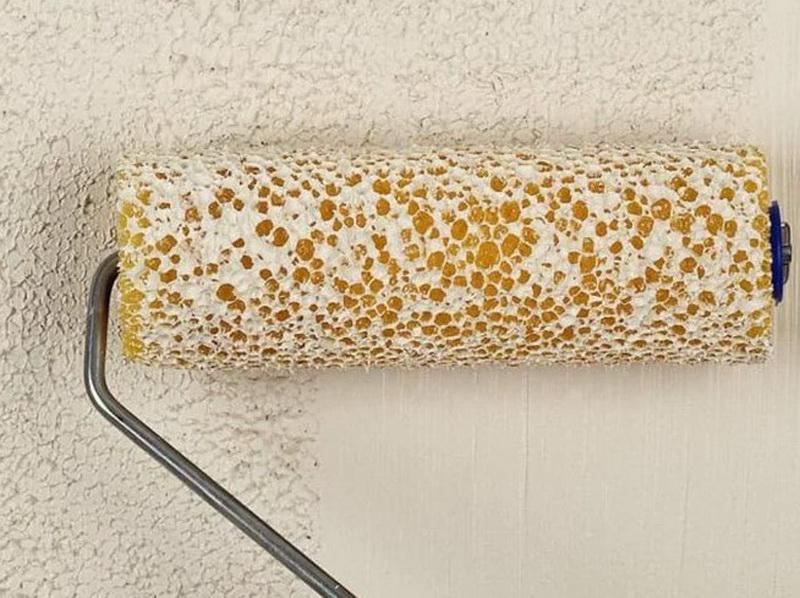



 Putting textured paint on walls – occupation the fascinating, allowing beginners to create unique finishing coverings. Such material makes related an opportunity to form the invoice by various ways of drawing with
Putting textured paint on walls – occupation the fascinating, allowing beginners to create unique finishing coverings. Such material makes related an opportunity to form the invoice by various ways of drawing with  (yet there are no estimates)
(yet there are no estimates)

 How to prepare a wall under decorative plaster of different types
How to prepare a wall under decorative plaster of different types
 Decorative plaster of facades: types, composition of mixes, preparation of works and tool
Decorative plaster of facades: types, composition of mixes, preparation of works and tool

 Decorative paint or decorative plaster, what is better
Decorative paint or decorative plaster, what is better